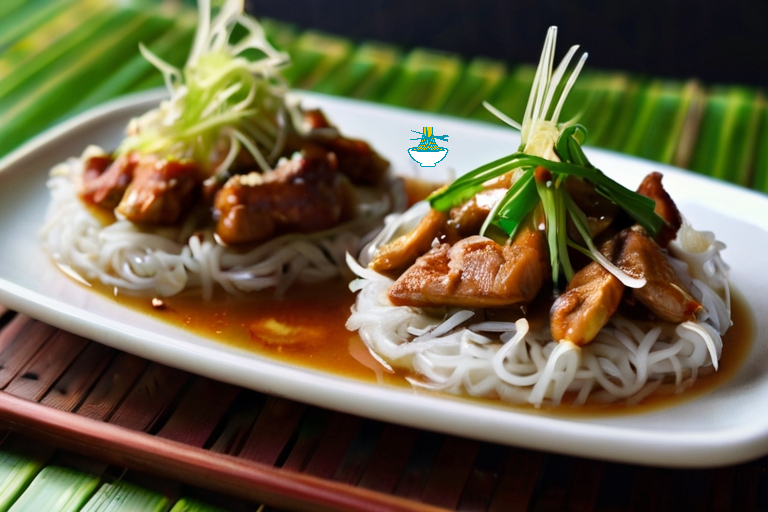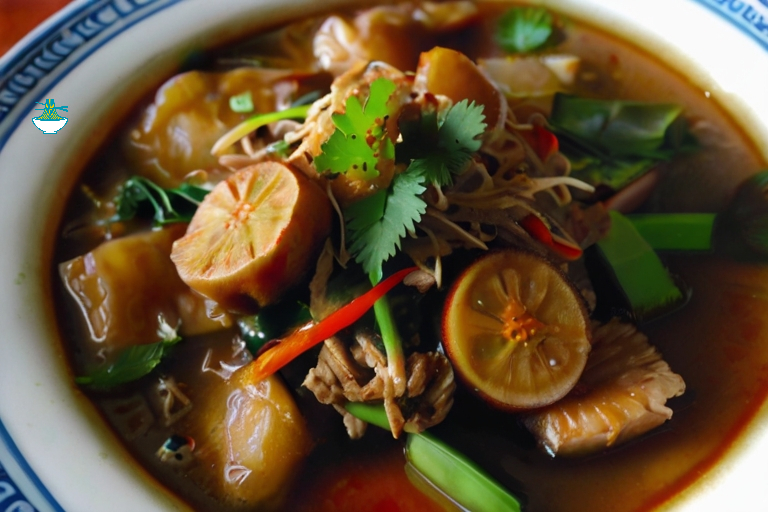Welcome to the vibrant world of Cambodian cuisine! Delve into the rich flavors and cultural heritage of Cambodia with this traditional recipe for Trey Chien Choun Pdei Doung, a mouthwatering seafood dish that embodies the essence of Cambodian culinary artistry. Known for its intricate blend of aromatic herbs and spices, Cambodian cuisine offers a delightful journey for the senses, and this recipe is no exception.
Trey Chien Choun Pdei Doung, which translates to "Fried Fish with Sweet and Sour Sauce," is a beloved dish that holds a special place in Cambodian culinary traditions. With its combination of fresh fish, tangy tamarind, palm sugar, and aromatic herbs, this dish perfectly encapsulates the balance of flavors that defines Cambodian cooking.
Join us as we embark on a culinary adventure to recreate this authentic Cambodian delicacy in your own kitchen. Whether you're a seasoned chef or an adventurous home cook, this recipe promises to transport you to the bustling markets and vibrant streets of Cambodia, where the aroma of spices fills the air and every bite tells a story of tradition and culture. So, let's gather our ingredients and embark on a culinary journey to discover the flavors of Cambodia through Trey Chien Choun Pdei Doung!
Ingredients:
For the Sweet and Sour Sauce:
- 1/2 cup palm sugar, grated
- 1/4 cup tamarind paste
- 1/4 cup water
- 2 tablespoons fish sauce
- 2 cloves garlic, minced
- 1 shallot, finely chopped
- 1 red chili, thinly sliced (optional)
- 1 tablespoon vegetable oil
For the Fried Fish:
- 1 whole fish (such as snapper or sea bass), cleaned and scaled
- Salt and pepper, to taste
- Vegetable oil, for frying
- 1/4 cup all-purpose flour
For Garnish (optional):
- Fresh cilantro leaves
- Sliced scallions
- Sliced red chili
Instructions:
Prepare the Sweet and Sour Sauce:
1- In a small bowl, mix the tamarind paste with water and let it soak for 10 minutes. Then strain the mixture to remove any seeds or fibers, leaving behind the tamarind juice.
2- In a saucepan, heat the vegetable oil over medium heat. Add the minced garlic, chopped shallot, and sliced red chili (if using). Sauté until fragrant, about 1-2 minutes.
3- Add the grated palm sugar to the saucepan and stir until it melts and caramelizes slightly, about 2-3 minutes.
4- Pour in the tamarind juice and fish sauce. Stir well to combine all the ingredients.
5- Simmer the sauce over low heat for 5-7 minutes, or until it thickens slightly. Taste and adjust seasoning if needed. Remove from heat and set aside.
Fry the Fish:
1- Pat the whole fish dry with paper towels. Score the fish on both sides with shallow diagonal cuts.
2- Season the fish generously with salt and pepper, including inside the cavity.
3- Dust the fish lightly with all-purpose flour, shaking off any excess.
4- In a large skillet or deep fryer, heat vegetable oil over medium-high heat until it reaches 350°F (180°C).
5- Carefully place the fish in the hot oil and fry until golden brown and crispy, about 6-8 minutes per side, depending on the size of the fish. Ensure the fish is cooked through and the flesh flakes easily with a fork.
6- Once fried, transfer the fish to a serving platter lined with paper towels to drain off any excess oil.
Serve:
1- Place the fried fish on a serving platter and pour the prepared sweet and sour sauce over the top.
2- Garnish with fresh cilantro leaves, sliced scallions, and additional sliced red chili, if desired.
3- Serve the Trey Chien Choun Pdei Doung immediately with steamed rice and enjoy the delicious flavors of Cambodian cuisine!
Note: Feel free to adjust the sweetness or sourness of the sauce according to your taste preference by adding more palm sugar or tamarind paste. Additionally, you can customize the level of spiciness by adjusting the amount of chili used in the sauce.
Nutritional Values:
Here are the approximate nutritional values for the ingredients used in the Cambodian Trey Chien Choun Pdei Doung recipe:
Palm sugar (1/2 cup, grated):
- Calories: 360
- Total Fat: 0g
- Sodium: 0mg
- Total Carbohydrates: 93g
- Sugars: 92g
- Protein: 0g
benefits: Palm sugar is a natural sweetener that contains essential vitamins and minerals such as iron, potassium, calcium, and vitamins B1, B2, B3, and B6. It is lower on the glycemic index compared to refined sugar, making it a better option for managing blood sugar levels.
Tamarind paste (1/4 cup):
- Calories: 120
- Total Fat: 1g
- Sodium: 12mg
- Total Carbohydrates: 31g
- Dietary Fiber: 2g
- Sugars: 23g
- Protein: 1g
benefits:Tamarind is rich in antioxidants, vitamins, and minerals. It contains compounds that may help lower cholesterol, aid digestion, and promote heart health. Tamarind is also known for its anti-inflammatory properties and may help reduce joint pain and inflammation.
Water (1/4 cup):
- No significant nutritional value.
benefits: Water is essential for hydration and helps regulate bodily functions such as temperature control, digestion, and nutrient absorption. It supports overall health and well-being.
Fish sauce (2 tablespoons):
- Calories: 30
- Total Fat: 0g
- Cholesterol: 20mg
- Sodium: 5100mg
- Total Carbohydrates: 1g
- Protein: 3g
benefits: Fish sauce is a good source of protein and contains essential amino acids. It also provides minerals such as calcium, phosphorus, and magnesium. Consuming fish sauce in moderation can contribute to a balanced diet and support muscle health.
Garlic (2 cloves, minced):
- Calories: 10
- Total Fat: 0g
- Sodium: 0mg
- Total Carbohydrates: 3g
- Dietary Fiber: 0g
- Sugars: 0g
- Protein: 0g
benefits: Garlic is packed with antioxidants and compounds that have antibacterial and antiviral properties. It may help boost the immune system, lower blood pressure and cholesterol levels, and improve heart health. Garlic is also known for its potential cancer-fighting properties.
Shallot (1, finely chopped):
- Calories: 10
- Total Fat: 0g
- Sodium: 1mg
- Total Carbohydrates: 2g
- Dietary Fiber: 0g
- Sugars: 1g
- Protein: 0g
benefits: Shallots are rich in antioxidants, vitamins, and minerals such as vitamin C, potassium, and manganese. They have anti-inflammatory properties and may help improve heart health, regulate blood sugar levels, and support bone health.
Red chili (1, thinly sliced, optional):
- Calories: 18
- Total Fat: 0g
- Sodium: 1mg
- Total Carbohydrates: 4g
- Dietary Fiber: 1g
- Sugars: 2g
- Protein: 1g
benefits: Red chili peppers contain capsaicin, a compound that gives them their spicy flavor and provides numerous health benefits. Capsaicin may help boost metabolism, reduce appetite, alleviate pain, and lower inflammation. Red chilies are also rich in vitamins A and C.
Vegetable oil (1 tablespoon):
- Calories: 120
- Total Fat: 14g
- Cholesterol: 0mg
- Sodium: 0mg
- Total Carbohydrates: 0g
- Protein: 0g
benefits: Vegetable oils, such as olive oil or sunflower oil, provide healthy fats that are essential for brain function, hormone production, and cell membrane integrity. They also contain vitamin E, an antioxidant that helps protect cells from damage caused by free radicals.
Whole fish (such as snapper or sea bass):
- Nutritional values vary depending on the type and size of the fish. Generally, fish is a good source of protein, omega-3 fatty acids, and various vitamins and minerals.
benefits: Whole fish is an excellent source of high-quality protein, omega-3 fatty acids, vitamins, and minerals. Consuming fish regularly can support heart health, brain function, and overall well-being.
All-purpose flour (1/4 cup):
- Calories: 114
- Total Fat: 0g
- Sodium: 0mg
- Total Carbohydrates: 24g
- Dietary Fiber: 1g
- Sugars: 0g
- Protein: 3g
benefits: All-purpose flour provides carbohydrates, which are the body's primary source of energy. It also contains small amounts of protein and fiber. However, it is less nutritious compared to whole grain flours.
Fresh cilantro leaves, sliced scallions, and sliced red chili:
- Negligible caloric content, mainly used for garnish.
benefits: These ingredients primarily serve as garnishes to enhance the flavor and presentation of the dish. Cilantro and scallions add freshness and aroma, while red chili adds a pop of color and heat.
These values are approximate and may vary based on factors such as brands used and specific preparation methods.


Comments